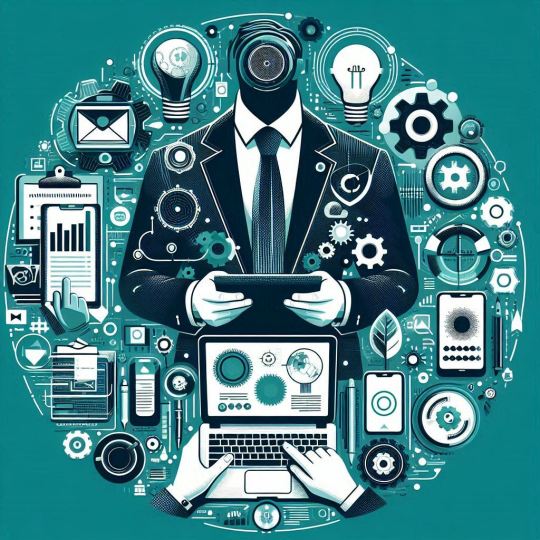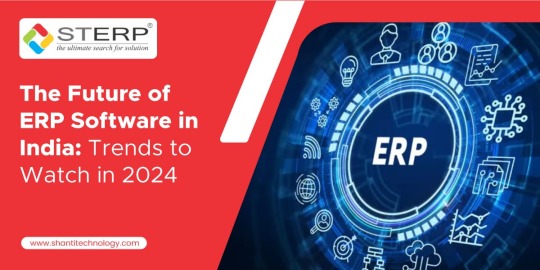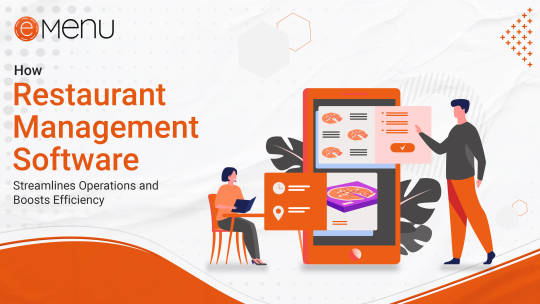#crm software for sales and order
Explore tagged Tumblr posts
Text
B2B order management software streamlines and automates the process of managing business-to-business orders. It helps companies track inventory, process orders, manage pricing, and improve customer relationships. With features like real-time order tracking, automated workflows, and integration with ERP and CRM systems, it enhances efficiency and reduces errors in the supply chain.
#b2b order management software#b2b order management system#order management tools#crm management software#best sales force automation software#top retail software companies
1 note
·
View note
Text
Best Restaurant Software In India
The restaurant industry in India is booming, with diverse cuisines, unique dining concepts, and fast-paced services driving customer satisfaction. Managing a restaurant, however, can be a daunting task. Thankfully, restaurant software in India has emerged as a game-changer, streamlining operations and helping restaurant owners focus on what matters most — serving their customers. In this blog, we’ll explore the benefits, features, and top options available in the realm of restaurant software in India.
Why You Need Restaurant Software in India

The Indian market offers a wide variety of restaurant software tailored to meet the needs of different types of establishments, whether you own a fine dining restaurant, a café, or a food delivery service. These tools help you manage operations with ease while enhancing the dining experience for your customers.
Features to Look for in Restaurant Software in India
Before choosing the best restaurant software in India for your business, it’s essential to identify the features that suit your requirements. Here are some key functionalities to consider:
✅ Point of Sale (POS) System: A robust POS system is the backbone of any restaurant software. It ensures seamless billing and order management.
✅ Inventory Management: Effective inventory management helps track stock levels, reduce waste, and forecast needs accurately.
✅ Online Order Integration: With food delivery services on the rise, integration with online platforms like Swiggy and Zomato is a must.
✅ Table Management: This feature is crucial for dine-in restaurants, allowing you to manage reservations and seating arrangements efficiently.
✅ Customer Relationship Management (CRM): CRM tools help maintain customer loyalty by storing data and creating targeted offers.
✅ Analytics and Reporting: Detailed insights into your restaurant’s performance enable better decision-making.
✅ Multi-Language Support: In a diverse country like India, having software that supports multiple languages can be a big advantage.
Benefits of Using Restaurant Software in India
✅ Improved Efficiency: Automation reduces errors and speeds up operations.
✅ Better Customer Experience: Quick service and personalized offers make diners happy.
✅ Cost Savings: Effective inventory management minimizes waste and saves money.
✅ Enhanced Online Presence: Integration with food delivery apps helps expand your reach.
Top Restaurant Software in India
Here is a curated list of some of the best restaurant software in India:
Petpooja: Known for its versatility, Petpooja offers features such as POS, inventory tracking, and online order integration. It’s ideal for all kinds of restaurants.
2. POSist: This cloud-based software is perfect for scaling up businesses. It provides advanced CRM tools, table management, and analytics.
3. inresto: A great choice for dine-in restaurants, inresto focuses on reservation management, feedback collection, and marketing automation.
4. Torqus: Torqus is a popular restaurant software in India that emphasizes ease of use and customization. It’s excellent for startups and chains.
5. UrbanPiper: If online orders are your primary focus, UrbanPiper’s integration with top food delivery platforms ensures a seamless experience.
6. NuznInfotech: NuznInfotech stands out with its comprehensive features like POS, inventory control, CRM, and online order integration. It’s one of the top choices for restaurant software in India, catering to both small outlets and large chains.
Choosing the Right Restaurant Software in India
When selecting restaurant software in India, consider the following tips:
Assess Your Needs: A small café’s requirements differ from a large chain’s. List your priorities before making a choice.
Check Reviews: User reviews and testimonials can provide valuable insights into the software’s performance.
Opt for a Demo: Most providers offer free trials or demos. Use this to test the features and interface.
Budget Consideration: Balance cost with functionality to get the best value for your investment.
The Future of Restaurant Software in India
With advancing technology, restaurant software in India is becoming more sophisticated. AI-driven analytics, voice-command interfaces, and blockchain-based solutions for payment security are some trends to watch. These innovations promise to make restaurant operations even more streamlined and customer-focused.
#best restaurant software in india#best pos software for restaurants in india#best billing software for restaurant in india#restaurant management software#best restaurant management software#restaurant POS software India#best POS billing software India#restaurant billing system India#restaurant POS system#restaurant operations software India#cloud-based restaurant management software#restaurant inventory management software India#restaurant reservation software India#restaurant ordering system software#best restaurant CRM software India#restaurant software for small business#best food delivery management software India#restaurant point of sale system India#restaurant kitchen management software#food and beverage management software India#best restaurant management tools#online ordering system for restaurants India#restaurant staff management software India#restaurant menu management software India#all-in-one restaurant software India#restaurant ordering and payment software#integrated restaurant POS software#restaurant business management software India#best restaurant management platform
0 notes
Text
Axolt: Modern ERP and Inventory Software Built on Salesforce
Today’s businesses operate in a fast-paced, data-driven environment where efficiency, accuracy, and agility are key to staying competitive. Legacy systems and disconnected software tools can no longer meet the evolving demands of modern enterprises. That’s why companies across industries are turning to Axolt, a next-generation solution offering intelligent inventory software and a full-fledged ERP on Salesforce.
Axolt is a unified, cloud-based ERP system built natively on the Salesforce platform. It provides a modular, scalable framework that allows organizations to manage operations from inventory and logistics to finance, manufacturing, and compliance—all in one place.
Where most ERPs are either too rigid or require costly integrations, Axolt is designed for flexibility. It empowers teams with real-time data, reduces manual work, and improves cross-functional collaboration. With Salesforce as the foundation, users benefit from enterprise-grade security, automation, and mobile access without needing separate platforms for CRM and ERP.
Smarter Inventory Software Inventory is at the heart of operational performance. Poor inventory control can result in stockouts, over-purchasing, and missed opportunities. Axolt’s built-in inventory software addresses these issues by providing real-time visibility into stock levels, warehouse locations, and product movement.
Whether managing serialized products, batches, or kits, the system tracks every item with precision. It supports barcode scanning, lot and serial traceability, expiry tracking, and multi-warehouse inventory—all from a central dashboard.
Unlike traditional inventory tools, Axolt integrates directly with Salesforce CRM. This means your sales and service teams always have accurate availability information, enabling faster order processing and better customer communication.
A Complete Salesforce ERP Axolt isn’t just inventory software—it’s a full Salesforce ERP suite tailored for businesses that want more from their operations. Finance teams can automate billing cycles, reconcile payments, and manage cash flows with built-in modules for accounts receivable and payable. Manufacturing teams can plan production, allocate work orders, and track costs across every stage.
86 notes
·
View notes
Text
AI Agent Development: How to Create Intelligent Virtual Assistants for Business Success
In today's digital landscape, businesses are increasingly turning to AI-powered virtual assistants to streamline operations, enhance customer service, and boost productivity. AI agent development is at the forefront of this transformation, enabling companies to create intelligent, responsive, and highly efficient virtual assistants. In this blog, we will explore how to develop AI agents and leverage them for business success.

Understanding AI Agents and Virtual Assistants
AI agents, or intelligent virtual assistants, are software programs that use artificial intelligence, machine learning, and natural language processing (NLP) to interact with users, automate tasks, and make decisions. These agents can be deployed across various platforms, including websites, mobile apps, and messaging applications, to improve customer engagement and operational efficiency.
Key Features of AI Agents
Natural Language Processing (NLP): Enables the assistant to understand and process human language.
Machine Learning (ML): Allows the assistant to improve over time based on user interactions.
Conversational AI: Facilitates human-like interactions.
Task Automation: Handles repetitive tasks like answering FAQs, scheduling appointments, and processing orders.
Integration Capabilities: Connects with CRM, ERP, and other business tools for seamless operations.
Steps to Develop an AI Virtual Assistant
1. Define Business Objectives
Before developing an AI agent, it is crucial to identify the business goals it will serve. Whether it's improving customer support, automating sales inquiries, or handling HR tasks, a well-defined purpose ensures the assistant aligns with organizational needs.
2. Choose the Right AI Technologies
Selecting the right technology stack is essential for building a powerful AI agent. Key technologies include:
NLP frameworks: OpenAI's GPT, Google's Dialogflow, or Rasa.
Machine Learning Platforms: TensorFlow, PyTorch, or Scikit-learn.
Speech Recognition: Amazon Lex, IBM Watson, or Microsoft Azure Speech.
Cloud Services: AWS, Google Cloud, or Microsoft Azure.
3. Design the Conversation Flow
A well-structured conversation flow is crucial for user experience. Define intents (what the user wants) and responses to ensure the AI assistant provides accurate and helpful information. Tools like chatbot builders or decision trees help streamline this process.
4. Train the AI Model
Training an AI assistant involves feeding it with relevant datasets to improve accuracy. This may include:
Supervised Learning: Using labeled datasets for training.
Reinforcement Learning: Allowing the assistant to learn from interactions.
Continuous Learning: Updating models based on user feedback and new data.
5. Test and Optimize
Before deployment, rigorous testing is essential to refine the AI assistant's performance. Conduct:
User Testing: To evaluate usability and responsiveness.
A/B Testing: To compare different versions for effectiveness.
Performance Analysis: To measure speed, accuracy, and reliability.
6. Deploy and Monitor
Once the AI assistant is live, continuous monitoring and optimization are necessary to enhance user experience. Use analytics to track interactions, identify issues, and implement improvements over time.
Benefits of AI Virtual Assistants for Businesses
1. Enhanced Customer Service
AI-powered virtual assistants provide 24/7 support, instantly responding to customer queries and reducing response times.
2. Increased Efficiency
By automating repetitive tasks, businesses can save time and resources, allowing employees to focus on higher-value tasks.
3. Cost Savings
AI assistants reduce the need for large customer support teams, leading to significant cost reductions.
4. Scalability
Unlike human agents, AI assistants can handle multiple conversations simultaneously, making them highly scalable solutions.
5. Data-Driven Insights
AI assistants gather valuable data on customer behavior and preferences, enabling businesses to make informed decisions.
Future Trends in AI Agent Development
1. Hyper-Personalization
AI assistants will leverage deep learning to offer more personalized interactions based on user history and preferences.
2. Voice and Multimodal AI
The integration of voice recognition and visual processing will make AI assistants more interactive and intuitive.
3. Emotional AI
Advancements in AI will enable virtual assistants to detect and respond to human emotions for more empathetic interactions.
4. Autonomous AI Agents
Future AI agents will not only respond to queries but also proactively assist users by predicting their needs and taking independent actions.
Conclusion
AI agent development is transforming the way businesses interact with customers and streamline operations. By leveraging cutting-edge AI technologies, companies can create intelligent virtual assistants that enhance efficiency, reduce costs, and drive business success. As AI continues to evolve, embracing AI-powered assistants will be essential for staying competitive in the digital era.
5 notes
·
View notes
Text
Best Business Software Tools in 2024
The right software tools can help increase productivity, draft operations more efficiently and promote company growth in today's high-paced business environment. Whether you are a start-up or an existing enterprise the following business software is necessary to improve different areas of your business.
1. Project Management: ClickUp

It is a feature-laden project manager that lets you handle tasks, projects, and workflows of all types. Its ease of use and user-friendly interface, complimented with diverse dashboards cater to audiences between small teams and large organizations. Task assignments, time tracking, goal setting, and collaboration options allow you to stop hopping between spreadsheets and emails so your projects are complete efficiently.
2. CRM–– Zoho CRM
Zoho CRM — Your Intelligent Customer Relationships Management System. Among other features, it has lead management, sales automation, and analytics to make sales performance improve on a consistent streamline both administrative aspect as well as customer satisfaction. Due to its integration capabilities with other Zoho products, as well as most third-party applications, It has become a flexible option for businesses that are ready to supercharge their customer relationship management.
3. Accounting: Zoho Books

Zoho Books- The Best Accounting Software for Business Owners Invoicing, expense tracking and financial reporting are some of its features. You can also rest assured that your taxes are being handled correctly and always have the latest view of your financial health to help you manage your finances better.
4. HR Management: monday. com HR
It is a complete human resources management software that helps companies to better structure their workforce. This system provides with facilities like employee on boarding, performance tracking, payroll management etc. With the platform's ease of use, UI simplicity, and automation capabilities in HR processes that would otherwise take hours away from key HR initiatives.
5. Payroll: OnPay

OnPay is an excellent payroll software for businesses of all sizes. It is a cloud payroll software for businesses that ensures complete compliance and automation of top-class payroll calculations, tax filings & employee payments. Additionally, OnPay provides HR and benefits management tools, effectively providing a full-fledged employee pay management solution.
6. Point-of-Sale (POS): eHopper
Versatile Point of Sale Software for Businesses Up To Mid-Sized It offers services like Inventory management, sales tracking and customer management. This makes eHopper a perfect choice for businesses that intend to simplify their sales operations using an affordable and intuitive POS system.
7. Inventory Management: Cin7

While there are plenty of other inventory management systems available, Cin7 stands out as one of the most popular options for small to mid-size businesses (SMBs) looking to get their stock levels, orders and supply chain operations under control. These functionalities consist of real-time inventory monitoring, order processing and e-commerce platform integration. With the powerful feature set of Cin7, businesses can keep inventory at an optimal level and fulfill customer demands to the hilt.
8. Website Builder: Weebly
Weebly is the website builder that you can also use to build your site or blog. It has lots of customizable templates, drag-and-drop functionality, and e-commerce ready to go. With Weebly, you can create a professional website even if you are a tech noob and give your business the relevant online visibility it needs.
9. Recruiting: ZipRecruiter

ZipRecruiter: Popular rated job search app for businesses on board. They provide hiring solutions through features like job posting candidates filtering and tracking the application. AI-powered matching from ZipRecruiter surfaces more relevant candidates to businesses faster.
10. VPN: NordVPN
It is a secure, encrypted VPN application that will make sure that you and your business stay safe as you work with the web. It provides features of encrypted connections, threat protection and global server access as well. In this way, It guarantees secure data in companies and privacy on internet.
Conclusion
The business software tools a company uses are very important to increase productivity and power growth. The above-mentioned tools are some of the best & flexible according to the fact which can assist businesses for any sized groups and help them attain their desired objectives. Implementing these tools in your operations can also help speed up processes and lead to higher customer satisfaction, as well as allow you to be on top of the competition.
#business#business growth#innovation#startup#entrepreneur#100 days of productivity#project management#sales#payroll#hr management#hr software#hr services#ai#artificial intelligence#technology#tech#techinnovation
3 notes
·
View notes
Text
Why B2B Sales Thrives with Quoting Software?
As VAR businesses engage in complex transactions with other businesses, the need for streamlined processes becomes even more critical. This is where quoting software plays a pivotal role in revolutionizing B2B sales, fostering efficiency, accuracy, and overall growth.
Quoting software simplifies the intricate process of generating and managing quotes, transforming what was once a time-consuming task into a swift and error-free operation. One of the primary benefits is the speed at which quotes can be generated.
In a competitive B2B landscape, being able to provide clients with quick and accurate quotes can be the difference between winning or losing a deal. The sales quoting software automates this process, allowing B2B sales teams to respond promptly to customer inquiries, thereby enhancing customer satisfaction and trust.
Eliminate Pricing Discrepancies in B2B Quoting
The accuracy of quotes is another crucial aspect of B2B sales, and quoting software significantly reduces the margin for errors. Manual quote generation can lead to miscalculations, pricing discrepancies, and other mistakes that may compromise the integrity of a deal.
Business sales quoting software, on the other hand, employ automation to ensure that quotes are consistent, error-free, and aligned with the pricing strategy of the business. This not only instills confidence in clients but also protects the business from potential disputes and financial losses.
Manage B2B Complexities with Ease
Furthermore, B2B quoting software facilitates customization, enabling businesses to tailor quotes based on specific customer needs and preferences. B2B transactions often involve complex pricing structures, volume discounts, and negotiated terms.
Quoting software allows sales teams to easily navigate these complexities, providing clients with personalized quotes that reflect their unique requirements. This level of flexibility not only enhances the customer experience but also positions the business as a responsive and adaptable partner in the eyes of clients.
Be aligned with your B2B Sales Strategy
The centralized nature of B2B sales quoting software for MSPs also contributes to improved collaboration within sales teams. With a unified platform for creating and managing quotes, team members can seamlessly share information, track changes, and collaborate in real time. This collaborative environment fosters better communication, reduces the risk of misunderstandings, and ensures that all team members are aligned with the overall sales strategy.
Streamline your B2B Sales
Moreover, B2B sales quoting software for VARs often integrates with other essential business tools, such as CRM systems and accounting software. This integration streamlines the entire sales process, from lead generation to order fulfillment.
It eliminates the need for manual data entry, reduces the likelihood of data errors, and provides a holistic view of the customer journey. This interconnected approach not only saves time but also empowers sales teams with actionable insights, enabling them to make informed decisions that drive business growth. The business quote generator is a catalyst for the thriving B2B sales landscape. Its ability to enhance speed, accuracy, customization, collaboration, and integration makes it an indispensable tool for businesses engaged in complex transactions. As B2B sales continue to evolve, leveraging quoting software will undoubtedly become a key strategy for staying competitive, fostering customer relationships, and ultimately achieving sustainable growth in the marketplace.
#ecommerce platform#varstreet#business software#sales quoting software#cpq software#ecommerce software#punchout catalog
11 notes
·
View notes
Text
youtube
MAGTEC Cloud ERP Software for Trading and Distribution offers a powerful suite of features to streamline business operations. It includes real-time inventory management, procurement and sales management, warehouse and logistics integration, and financial tools like automated invoicing and tax handling. The software automates order management with features like backorder handling and CRM integration, and supports communication via WhatsApp, email, and SMS. With robust reporting and analytics, a mobile app for on-the-go management, and comprehensive supplier and vendor management
Visit our website www.magtecsolutions.com
2 notes
·
View notes
Text
The Future of ERP Software in India: Trends to Watch in 2024
As India continues to solidify its position as a global economic powerhouse, the demand for sophisticated Enterprise Resource Planning (ERP) solutions has never been higher. ERP software companies in India are at the forefront of this transformation, driving innovation and efficiency across various industries. As we look ahead to 2024, several key trends are shaping the future of ERP software in India. This blog delves into these trends, offering insights into how ERP software providers in India are gearing up to meet the evolving needs of businesses.

1. Increased Adoption of Cloud-Based ERP Solutions
One of the most significant trends in the ERP landscape is the shift towards cloud-based solutions. ERP software companies in India are increasingly offering cloud-based ERP systems to meet the growing demand for flexibility, scalability, and cost-efficiency. Cloud ERP solutions eliminate the need for extensive on-premises infrastructure, allowing businesses to reduce capital expenditure and streamline operations.
Cloud-based ERP systems also facilitate real-time data access and collaboration, enabling businesses to make informed decisions quickly. This trend is particularly beneficial for small and medium-sized enterprises (SMEs) that require affordable and scalable ERP solutions to compete effectively in the market.
2. Integration of Artificial Intelligence and Machine Learning
Artificial Intelligence (AI) and Machine Learning (ML) are revolutionizing the ERP landscape. ERP software providers in India are integrating AI and ML technologies to enhance the capabilities of their solutions. These technologies enable predictive analytics, automate routine tasks, and provide intelligent insights, helping businesses to optimize their operations.
For instance, AI-powered ERP systems can forecast demand, manage inventory levels, and predict maintenance needs, significantly improving efficiency and reducing costs. As AI and ML technologies continue to evolve, their integration into ERP systems will become more sophisticated, offering even greater value to businesses.
3. Focus on Industry-Specific ERP Solutions
ERP software companies in India are increasingly developing industry-specific ERP solutions to cater to the unique needs of different sectors. Whether it is manufacturing, retail, healthcare, or finance, each industry has distinct requirements that generic ERP systems might not fully address. Industry-specific ERP solutions offer tailored functionalities and workflows, ensuring better alignment with business processes.
For example, a manufacturing ERP system might include features for production planning, quality control, and supply chain management, while a retail ERP system could focus on inventory management, point of sale (POS) integration, and customer relationship management (CRM). This trend towards specialization ensures that businesses can leverage ERP systems that truly support their operational needs.
4. Enhanced Mobile Accessibility
With the proliferation of smartphones and mobile devices, the need for mobile-friendly ERP solutions is growing. ERP software providers in India are developing mobile applications that allow users to access critical business information on the go. Mobile ERP solutions enable employees to perform tasks such as inventory checks, sales order processing, and expense reporting from their smartphones or tablets.
This trend not only improves accessibility but also enhances productivity by enabling employees to work remotely and make decisions in real-time. As mobile technology continues to advance, the functionality and user experience of mobile ERP applications will improve, making them an indispensable tool for modern businesses.
5. Increased Emphasis on Data Security and Compliance
As businesses become more reliant on digital technologies, data security and compliance have become paramount. ERP software providers in India are prioritizing data protection by incorporating advanced security features into their solutions. This includes encryption, multi-factor authentication, and regular security audits to safeguard sensitive business information.
Moreover, with the implementation of regulations such as the General Data Protection Regulation (GDPR) and India’s Personal Data Protection Bill, compliance is a critical concern for businesses. ERP software providers are ensuring that their systems comply with these regulations, helping businesses avoid legal penalties and build trust with their customers.
6. Rise of Hybrid ERP Solutions
While cloud-based ERP systems offer numerous advantages, some businesses prefer on-premises solutions due to specific regulatory or operational requirements. To cater to these diverse needs, ERP software companies in India are offering hybrid ERP solutions that combine the benefits of both cloud and on-premises systems.
Hybrid ERP solutions provide the flexibility of cloud-based systems while allowing businesses to maintain critical applications on-premises. This approach offers a balanced solution, enabling businesses to optimize their IT infrastructure based on their unique needs and preferences.
7. Adoption of Advanced Analytics and Business Intelligence
Data is the new currency in today’s business environment, and the ability to harness and analyze data is a key competitive advantage. ERP software providers in India are integrating advanced analytics and business intelligence (BI) tools into their systems. These tools enable businesses to gain deep insights into their operations, identify trends, and make data-driven decisions.
Advanced analytics and BI tools can analyze large volumes of data from various sources, providing comprehensive reports and dashboards. This helps businesses to monitor performance, identify inefficiencies, and uncover new opportunities for growth.
8. Greater Focus on User Experience and Interface Design
The user experience (UX) and interface design of ERP systems are critical to their adoption and effectiveness. ERP software companies in India are placing a greater emphasis on developing intuitive and user-friendly interfaces. This trend is driven by the need to ensure that ERP systems are accessible and easy to use for all employees, regardless of their technical expertise.
Modern ERP systems feature clean, responsive interfaces with customizable dashboards and navigation options. This focus on UX design helps to improve user satisfaction, reduce training time, and increase overall productivity.
9. Integration with the Internet of Things (IoT)
The Internet of Things (IoT) is transforming the way businesses operate by enabling real-time monitoring and data collection from connected devices. ERP software providers in India are integrating IoT capabilities into their systems to enhance operational efficiency and decision-making.
IoT-enabled ERP systems can monitor equipment performance, track inventory levels, and optimize supply chain operations. For example, sensors placed on manufacturing equipment can detect anomalies and trigger maintenance requests before a breakdown occurs. This integration of IoT with ERP systems allows businesses to leverage real-time data for proactive management and improved efficiency.
10. Sustainable and Green ERP Solutions
Sustainability is becoming a key consideration for businesses across industries. ERP software companies in India are developing solutions that support sustainable practices and environmental responsibility. Green ERP solutions help businesses to monitor and reduce their environmental impact by tracking energy consumption, waste management, and resource utilization.
By integrating sustainability metrics into their ERP systems, businesses can set and achieve environmental goals, comply with regulations, and enhance their corporate social responsibility (CSR) initiatives. This trend towards sustainable ERP solutions reflects the growing importance of environmental stewardship in today’s business landscape.
Conclusion
The future of ERP software in India is marked by innovation, adaptability, and a deep understanding of the unique needs of businesses. ERP software providers in India are leading the charge, offering solutions that are not only technologically advanced but also aligned with the evolving demands of the market. As we move into 2024, the trends highlighted in this blog will play a crucial role in shaping the ERP landscape, driving efficiency, and fostering growth across industries.
ERP software providers in India are well-positioned to support businesses in their digital transformation journeys, providing the tools and insights needed to thrive in a competitive environment. By staying ahead of these trends, businesses can leverage ERP solutions to achieve operational excellence and sustainable growth.
#ERP software Companies in India#ERP software providers in India#ERP software company in India#ERP software in India#ERP solution provider#ERP software#ERP system#cloud ERP#ERP solutions
4 notes
·
View notes
Text
Best Restaurant POS Software 2024 in India | Ciferon

Step into the future of restaurant management with cutting-edge Point of Sale (POS) software tailored for the Indian market in 2024. Our comprehensive solution is designed to streamline operations, enhance efficiency, and elevate customer experiences. With intuitive interface design and robust features, managing orders, inventory, and payments becomes seamless. From fine dining establishments to bustling cafes, the best restaurant POS software with Ciferon , offers customizable solutions to meet the unique needs of every business. Harness the power of real-time analytics to make data-driven decisions, optimize menu offerings, and drive profitability. With integrated CRM capabilities, forge stronger connections with your patrons and keep them coming back for more. Embrace the next generation of restaurant technology and stay ahead of the competition with our innovative POS sofware in India.
To know more-
2 notes
·
View notes
Text
Salon Management Software: The Key to Streamlining Your Salon Business
Salon management software has emerged as a game-changer, revolutionizing the way salons operate. This blog will delve into the essentials of salon management and explore the transformative role of salon POS software in streamlining business operations.

I. Understanding Salon Management:
Salon management involves overseeing the various aspects of a salon business, from appointment scheduling and inventory management to employee scheduling and customer relationship management. The goal is to create a seamless experience for both clients and salon staff.
II. The Importance of Salon Management Software:
Appointment Scheduling:
Efficiently manage appointments, reduce no-shows, and optimize staff schedules with the help of salon management software. Clients can book appointments online, and staff can access real-time schedules, enhancing overall workflow.
Inventory Management:
Keep track of products, manage stock levels, and streamline the ordering process. Salon management software helps avoid product shortages, reducing the risk of missed sales opportunities.
Customer Relationship Management (CRM):
Build lasting relationships with clients by utilizing CRM features. Personalized client profiles, appointment history, and automated reminders contribute to enhanced customer satisfaction and loyalty.
III. Salon POS Software: A Closer Look:
What is Salon POS Software?
Salon POS software, or Point of Sale software, is a specialized system designed to handle transactions and streamline the sales process in a salon. It combines the functionality of a cash register with advanced features tailored to the unique needs of the beauty industry.
Key Features of Salon POS Software:
Transaction Processing:
Facilitate quick and secure transactions, including cash, credit cards, and digital payments, providing convenience for both clients and staff.
Inventory Integration:
Seamlessly integrate with salon management software to ensure real-time updates on product availability and sales data.
Appointment Management:
Sync with the appointment scheduling system to unify the booking and payment processes, reducing wait times and enhancing the overall client experience.
Reporting and Analytics:
Generate comprehensive reports on sales, popular services, and inventory turnover, enabling informed decision-making for business growth.
IV. How Salon POS Software Streamlines Your Business:
Efficient Transactions:
Salon POS software speeds up the checkout process, minimizing waiting times and enhancing the overall customer experience.
Accurate Inventory Management:
Real-time updates on inventory levels and sales data help salon owners make informed decisions, preventing overstock or shortages.
Integrated Systems:
The seamless integration of salon POS software with management tools ensures a synchronized and efficient operation, reducing manual errors and increasing productivity.
Conclusion:
Salon management software, coupled with a robust POS system, is undeniably the key to streamlining your salon business. From optimizing appointments to managing inventory and enhancing customer relationships, these tools empower salon owners to focus on what they do best – providing exceptional beauty services while ensuring a smooth and efficient operation. Embrace the technological revolution in the beauty industry and watch your salon thrive.
#salon pos software#salon billing software#best salon software for small business#salon software in india#salon management software
2 notes
·
View notes
Text
API Integration Services for Your Business?

Introduction: The Blueprint of Connectivity - API Integration Services for Your Business
In today's interconnected digital landscape, the success of a business is often determined by its ability to seamlessly integrate various software systems, applications, and data sources. This is where the game-changing API Integration Services step in, redefining how businesses function and collaborate. In this blog post, we will embark on a journey into the world of API Integration, uncovering its unparalleled benefits and exploring how it can reshape the very core of your business operations.
Section 1: The API Integration Advantage: A Foundation for Growth
Imagine a scenario where your e-commerce platform effortlessly syncs with your inventory management system, customer data flows smoothly between your CRM and email marketing tool, and real-time updates are instantly reflected across your platforms. This is the power of API Integration Services, the engine that drives data connectivity and collaboration in the digital age. By establishing a foundation of interconnectedness, businesses can harness the potential of their existing tools and software, enhancing efficiency, accuracy, and agility.
Section 2: Streamlining Operations for Efficiency and Productivity
In the dynamic world of business, time is money, and every second counts. Manual data entry, duplicate tasks, and disjointed processes can drain valuable resources and hinder productivity. API Integration Services eliminate these roadblocks by automating data exchange and workflow processes. Consider a scenario where customer orders placed on your website are automatically updated in your CRM and inventory management system, triggering the packaging and shipping process without manual intervention. This not only speeds up order fulfillment but also reduces the risk of errors, allowing your team to focus on strategic initiatives rather than repetitive tasks.
Section 3: The Customer-Centric Revolution
Customer expectations have evolved, and businesses must adapt to deliver exceptional experiences. API Integration Services empower businesses to consolidate customer data from various touchpoints, providing a holistic view of each customer's interactions and preferences. Imagine the power of personalized marketing campaigns that are fueled by data from past purchases, browsing behavior, and support interactions. This level of personalization enhances customer engagement and loyalty, driving revenue growth and setting your business apart in a competitive landscape.
Section 4: Driving Data-Backed Decision Making
In the age of information, data is a priceless asset. API Integration Services provide the infrastructure for accurate and real-time data sharing across departments, enabling informed decision-making. For instance, a retail business can leverage API integration to connect its sales data with inventory levels and customer feedback, facilitating data-backed restocking decisions, targeted promotions, and strategic product launches. This not only minimizes guesswork but also positions your business to respond swiftly to market trends and customer demands.
Section 5: The Flexibility to Scale and Innovate
As businesses grow, their technology needs evolve. API Integration Services offer the flexibility to seamlessly incorporate new tools, applications, and platforms into your existing infrastructure. Whether you're adopting cutting-edge analytics software, expanding into new markets, or integrating with third-party services, APIs provide a bridge that supports growth without the headache of disruptive system overhauls. This scalability ensures that your business remains agile and adaptable in the face of changing landscapes.
Section 6: A Closer Look at API Integration Strategies
Effective API Integration is not a one-size-fits-all endeavor. It requires a strategic approach tailored to your business's unique requirements. Our team of experts specializes in crafting API Integration strategies that align with your goals and systems. We assess your existing infrastructure, identify integration opportunities, and design a roadmap that ensures a seamless and secure data exchange. Whether you're implementing a point-to-point integration or orchestrating a more complex ecosystem, our strategic approach guarantees a streamlined implementation.
Section 7: Breaking Down Silos for Enhanced Collaboration
Silos within an organization can hinder communication, stifle innovation, and impede growth. API Integration Services break down these barriers by fostering collaboration across departments and teams. For instance, in a manufacturing company, APIs can enable real-time data sharing between production, logistics, and quality control, leading to better coordination, improved efficiency, and reduced delays. This collaborative approach not only enhances internal operations but also improves customer satisfaction by delivering a more cohesive and responsive experience.
Section 8: Future-Proofing Your Business
In a rapidly evolving digital landscape, staying ahead of the curve is paramount. API Integration Services provide the agility to adapt to emerging technologies, tools, and trends. By embracing a future-proof approach, your business can leverage new opportunities, remain competitive, and maintain a cutting-edge presence. The ability to integrate with emerging technologies such as AI, IoT, and blockchain positions your business for sustained success in an ever-changing world.
Section 9: Transform Your Business with API Integration Services
In the grand symphony of modern business, API Integration Services play the role of the conductor, harmonizing data, processes, and systems into a unified masterpiece. As we conclude our exploration, it's evident that API Integration has the potential to transform your business by enhancing efficiency, streamlining operations, and delivering exceptional customer experiences. Embrace the power of connectivity and let API Integration Services propel your business into a future of growth and innovation.
API Integration Services are the gateway to a connected and efficient business ecosystem. With our expert guidance, you can unlock the full potential of seamless data exchange, streamline operations, and drive growth in today's digital landscape.
Meta Description: Elevate your business to new heights with our comprehensive API Integration Services. Discover how harnessing the potential of seamless data connectivity can revolutionize your operations and drive growth.
2 notes
·
View notes
Text
pleasedontcrashpleasedontcrash
So, after a solid week of nonsense, our network and software is back up and working perfectly - both old and new systems. Apparently, it was a cloud provider issue, now resolved, but it's making Boss rethink a lot of things. Boss has resisted having our customers input their payment info for this very reason. We take the info, call it in, shred the paper in a crosscutter. The payment information is kept on a second computer with no network connection, backed up onto an external HD. Every company we've worked with has treid to push us into taking payments online. Nope. Nope. Nope. We had one breach with a payment processor, one time, and haven't done it since.
S, N, C, and I are old-school - we used Outlook, Excel, and bookkeeping apps to keep ourselves running, generate sales orders and ship docs. Our picking software, CRM, and everything cloud-based was naturally tits-up, too.
SAAS is great until it isn't.
Now, pleasedontcrashpleasedontcrash-
2 notes
·
View notes
Text
How Restaurant Management Software Streamlines Operations and Boosts Efficiency

The restaurant industry is highly competitive, and efficient operations play a crucial role in the success of any establishment. In today's digital age, restaurant management software has emerged as a powerful tool to streamline operations and boost efficiency. This blog post explores the various ways in which restaurant management software revolutionizes the way restaurants operate, enabling them to deliver exceptional customer experiences while optimizing their backend processes.
The Role of Restaurant Management Software:
Online eMenu Restaurant management software is a comprehensive solution designed to handle the diverse aspects of running a restaurant. It encompasses a wide range of features and functionalities that simplify day-to-day operations, enhance productivity, and improve overall efficiency. From Restaurant tasks to Restaurant operations, the software offers a centralized platform to manage and streamline various processes.
Streamlining Restaurant Operations:
In the bustling environment of a restaurant, managing Restaurant operations efficiently is essential. Online eMenu Restaurant management software offers tools for reservation and table management software, allowing customers to book tables online and providing staff with real-time updates on reservations. This helps optimize table turnover and maximize seating capacity, leading to better customer service and increased revenue. Additionally, the software integrates with the point-of-sale (POS) system, enabling seamless order taking and processing.
Enhancing Restaurant Efficiency:
Efficiency in the Restaurant operations is equally important for smooth restaurant functioning. With restaurant management software, staff scheduling and labor management become hassle-free. The software automates scheduling, taking into account factors such as staff availability and workload, resulting in optimized staff allocation and improved productivity. It also tracks labor costs and performance metrics, providing valuable insights for effective decision-making.
Supplier and procurement management is another critical aspect that software addresses. By streamlining the ordering process and managing suppliers, restaurants can ensure timely and accurate deliveries. The software facilitates inventory forecasting, minimizing wastage and optimizing stock levels. Real-time reporting and analytics capabilities empower restaurant owners and managers to monitor sales, expenses, and performance, enabling data-driven decision-making.
Customer Relationship Management (CRM):
Building strong customer relationships is vital for the success of any restaurant. Restaurant management software Customer Relationship Management (CRM) helps in creating and maintaining customer profiles, capturing preferences, and analyzing data to deliver personalized experiences. Additionally, the software facilitates the implementation of loyalty programs and targeted marketing campaigns, allowing restaurants to engage with customers effectively and increase customer retention.
Ensuring Data Security and Accessibility:
Data security is a paramount concern in today's digital landscape. Restaurant management software offers robust security measures to protect sensitive customer information and business data. Cloud-based solutions provide data backup and ensure accessibility from anywhere, anytime, allowing owners and managers to monitor and manage their restaurant's operations remotely. User access control features further enhance data privacy and confidentiality.
Case Studies: Success Stories of Restaurant Management Software Implementation
Real-life examples of restaurants that have implemented restaurant management software can provide valuable insights into its effectiveness. Case studies highlighting specific improvements and outcomes achieved through the software demonstrate how it has helped restaurants streamline their operations, enhance efficiency, and deliver exceptional dining experiences.
Challenges and Considerations:
While restaurant management software offers numerous benefits, it's essential to consider potential challenges and factors when selecting the right software. Factors such as cost, scalability, user-friendliness, and integration capabilities with existing systems should be evaluated before making a decision. Addressing these considerations ensures a successful implementation and maximizes the software's potential.
Conclusion:
Restaurant Management software has become a game-changer in the industry, revolutionizing the way restaurants operate. By streamlining operations, enhancing efficiency, and optimizing processes, this software empowers restaurants to deliver exceptional customer experiences while driving profitability. As technology continues to shape the future of the restaurant industry, embracing restaurant management software becomes essential for those seeking.
#restaurant management software#contactless menu system#qr code#restaurant management system#restaurant pos system#contactless menu#contactless qr code menu#contactless ordering app#point-of-sale (POS) system#point-of-sale system#pos billing software#restaurant pos software#pos system#pos software#restaurant software#restaurant sales#restaurant#qrcodemenu#qr code menu#cloud based pos billing system#cloud based pos billing software#crm software#crmintegration#restaurant crm#restaurant crm software#crm development#online food ordering software#online food ordering system#food ordering system online#Restaurant Table Booking
4 notes
·
View notes
Text
Billing to Inventory in One Click: How POS Software Can Transform Your Outlet
In today’s fast-moving retail and food service landscape, efficiency isn’t just a goal—it’s a necessity. Whether you run a bakery, restaurant, supermarket, or franchise outlet, the time between billing a customer and updating your stock can make or break your operations. That’s where modern Point of Sale (POS) software comes in, transforming the way outlets manage transactions, inventory, and overall business flow.
The Traditional Problem: Disconnected Systems, Manual Work
In many traditional setups, the billing counter and the stockroom operate in silos. When a sale is made, the cashier records it manually or through a basic billing tool. Meanwhile, someone else has to update inventory records—either end of day or periodically. This manual and delayed process often leads to:
Stock mismatches
Over-ordering or under-stocking
Wasted inventory or spoilage
Inaccurate reporting
Revenue leakage
And worst of all? Your team spends valuable time on clerical work instead of improving customer experience or growing the business.
The Modern Solution: One-Click POS with Inventory Sync
A smart, cloud-based POS software integrates your billing and inventory systems in real-time. The moment a product is billed at the counter, the system instantly deducts it from your inventory—no manual entry, no delays, no confusion.
Here’s how it works:
Product Sold at POS A customer purchases a product or a menu item.
Real-Time Inventory Update As soon as the bill is generated, the software reduces stock from the backend inventory.
Auto Alerts for Reorder Levels If the stock goes below a defined threshold, the system sends alerts or creates purchase requests.
Dashboards & Analytics Managers can view real-time sales, stock movement, and profitability insights on a centralized dashboard—even remotely.
Key Benefits of Billing-Integrated Inventory Management
1. Zero Manual Errors
When billing and inventory are linked, human error is significantly reduced. No more forgetting to deduct sold items or entering wrong quantities in stock registers.
2. Saves Time and Manpower
Your staff doesn’t need to reconcile bills with stock manually. That saved time can now be invested in sales, service, or strategy.
3. Better Stock Planning
Track fast-moving and slow-moving items in real-time. Predict demand patterns and avoid stock-outs or overstocking.
4. Accurate Profitability Insights
With real-time data on what is sold and what remains in stock, you can calculate actual margins, wastage, and cost-to-sale ratios instantly.
5. Simplified Returns & Expiry Management
When customers return items or when perishables expire, smart POS systems can reverse stock or flag them accordingly—keeping your numbers clean and compliant.
6. Multi-Outlet Control
For chains or franchise models, cloud-based POS lets you monitor all your outlets from a single dashboard—track stock, sales, wastage, and performance outlet-wise.
Why Businesses Are Shifting to Smart POS Platforms
Modern businesses don’t just want automation—they want intelligent automation. The new generation of POS software is no longer just a billing machine. It’s a complete business intelligence tool that connects your sales, stock, customer data, pricing, accounting, and even loyalty programs into one seamless system.
Features to Look for in a Smart POS System:
Cloud-based access
Real-time inventory sync
Ingredient-level inventory tracking (for food outlets)
Multi-device & multi-location support
Reports & analytics dashboards
CRM & loyalty program integration
Mobile app access for owners & managers
Offline billing capability
Final Thoughts: It's Time to Modernize Your Outlet
Running an outlet today is all about speed, precision, and insight. A smart POS software transforms your operations from reactive to proactive. With real-time billing-to-inventory synchronization, you eliminate guesswork and unlock the power of accurate data—so you can serve better, grow faster, and scale smarter.
Whether you're operating a single store or managing a growing franchise, the switch to a smart POS system with integrated inventory is no longer optional—it’s a competitive edge.
Ready to transform your outlet? Explore how BETs Point of Sale System can simplify your operations from billing to stockroom in one click.
To know more,
Visit Us : https://www.byteelephants.com/
0 notes
Text
Mastering ERP: Essential Training Tips for Beginners and Professionals

Enterprise Resource Planning (ERP) systems have become the backbone of modern business operations. From finance and inventory to human resources and customer management, ERP platforms unify data and processes across departments to improve productivity, accuracy, and decision-making. However, the complexity of ERP software means that both beginners and experienced users need well-structured training to truly master the system.
Whether you're implementing a new ERP solution or looking to enhance your team’s skills, this article outlines essential ERP training tips for both beginners and professionals to ensure smooth adoption, confidence, and long-term success.
Why ERP Mastery Matters
A powerful ERP system is only as effective as its users. Inadequate training can lead to data errors, workflow disruptions, and underutilization of key features. On the other hand, strong ERP knowledge empowers users to work more efficiently, adapt to change, and support business growth.
Mastering ERP helps users to:
Navigate the system confidently
Reduce dependency on IT support
Handle daily operations efficiently
Identify and resolve system-related issues
Leverage advanced features for strategic insight
Tips for ERP Beginners
If you or your team are just starting out with ERP software, the learning curve can be steep. Here’s how to ease the transition:
1. Understand the Big Picture
Before diving into screens and forms, beginners should understand the core purpose of the ERP system and how it supports the business.
Learn about:
How different modules (finance, HR, inventory, etc.) work together
Key business processes and where the ERP fits in
The benefits ERP brings to your specific role
2. Take Role-Based Training
Focus on the features and workflows most relevant to your daily responsibilities. You don’t need to learn everything at once—start with what matters most to your job.
Examples:
Finance users should focus on accounts payable/receivable, reporting, and general ledger tasks.
Warehouse staff need training on inventory transactions and logistics.
Sales reps should concentrate on CRM, order entry, and customer data.
3. Use Hands-On Practice
Theory is important, but real understanding comes through doing. Use a test environment or sandbox to practice tasks in a safe, no-risk setting.
Practice tasks might include:
Entering and editing transactions
Running reports
Navigating the user interface efficiently
4. Ask Questions and Use Support Resources
Don’t be afraid to ask questions. Engage with trainers, ERP champions in your company, or help desk teams. Leverage user guides, FAQs, and video tutorials for quick answers.
Tip: Keep a personal list of “how-tos” for daily tasks to refer back to.
5. Start with the Basics and Build Up
Start with foundational tasks and gradually expand your knowledge. Avoid overwhelm by focusing on core tasks first, then exploring advanced functions once you're confident.
Tips for ERP Professionals and Power Users
If you're already familiar with ERP basics, it’s time to build deeper expertise and become a resource for others in your organization.
1. Explore Advanced Features and Analytics
Many ERP systems offer powerful tools that are underused. Professionals should learn to:
Build custom dashboards and KPIs
Automate recurring tasks and approvals
Use forecasting and budgeting tools
Create advanced reports with data visualization
Tip: Attend vendor webinars or certification courses to stay up to date.
2. Understand System Configuration and Workflow Logic
Going beyond user tasks, experienced users should understand how and why the system works the way it does.
Study:
How workflows are set up and approved
How data flows between modules
How configurations affect outcomes (e.g., tax settings, inventory valuation methods)
3. Stay Updated on System Changes
ERP systems are regularly updated with new features, UI changes, or security enhancements. Staying current ensures you're using the system optimally and training others accurately.
Strategies:
Subscribe to vendor newsletters or release notes
Participate in user communities or forums
Attend annual ERP user conferences if available
4. Mentor and Train Others
Experienced ERP users play a key role in user adoption. Becoming an internal trainer or ERP champion not only reinforces your own knowledge but helps elevate team performance.
Ways to contribute:
Host lunch-and-learns or mini training sessions
Create quick-reference guides for coworkers
Offer to shadow new users and answer questions
5. Track and Analyze System Use
Use built-in ERP tools or reports to monitor usage and identify inefficiencies. You can help your team optimize processes by spotting bottlenecks or recommending improvements.
Example: Noticing repeated invoice errors? Consider additional training or revising the input process.
General Best Practices for All ERP Learners
Whether you're a novice or an advanced user, the following principles apply across all skill levels:
Be patient. ERP mastery doesn’t happen overnight. Continuous learning is key.
Document as you learn. Maintain a personal or shared log of helpful processes.
Practice regularly. Like any tool, proficiency improves with consistent use.
Keep learning. ERP systems evolve—your skills should too.
Focus on impact. Always connect your training back to how it supports business outcomes.
Final Thoughts
Mastering ERP is a journey—not a one-time event. With the right training, both beginners and experienced professionals can fully leverage the power of ERP to streamline operations, reduce errors, and make smarter decisions. Whether you're entering your first invoice or building advanced reports, these training tips will help you build confidence and contribute to your organization’s success.
Investing time in ERP mastery isn’t just good for personal development—it’s essential for driving efficiency, improving collaboration, and supporting long-term business growth.
Contact Info
1 Westbrook Corporate Center, Westchester, IL 60154, US
(708) 722–5385
0 notes
Text
Groweon CRM Software has different modules capable of addressing challenges faced by different indian businesses. From Lead management, follow-up automation, order fulfilment, customer support, AMC Reminders, Order Management, Groweon CRM Software streamline your business operations, improves productivity, and closes deals faster.
Whether you're a startup or a growing company, Groweon adapts to your sales process and brings complete visibility into your customer lifecycle.
#crmsoftware#groweoncrm#crm software#crm solutions#apis integration#groweondigitalprivatelimited#serviceticketmanagement#leadmanagementcrmsoftware#marketing
0 notes